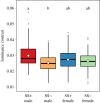Sexual selection drives the evolution of male wing interference patterns
- PMID: 31138076
- PMCID: PMC6545089
- DOI: 10.1098/rspb.2018.2850
Sexual selection drives the evolution of male wing interference patterns
Abstract
The seemingly transparent wings of many insects have recently been found to display unexpected structural coloration. These structural colours (wing interference patterns: WIPs) may be involved in species recognition and mate choice, yet little is known about the evolutionary processes that shape them. Furthermore, to date investigations of WIPs have not fully considered how they are actually perceived by the viewers' colour vision. Here, we use multispectral digital imaging and a model of Drosophila vision to compare WIPs of male and female Drosophila simulans from replicate populations forced to evolve with or without sexual selection for 68 generations. We show that WIPs modelled in Drosophila vision evolve in response to sexual selection and provide evidence that WIPs correlate with male sexual attractiveness. These findings add a new element to the otherwise well-described Drosophila courtship display and confirm that wing colours evolve through sexual selection.
Keywords: Drosophila; courtship; evolution; sensory ecology; sexual selection.
Conflict of interest statement
There are no competing interests.
Figures




Similar articles
-
Sexual selection on wing interference patterns in Drosophila melanogaster.Proc Natl Acad Sci U S A. 2014 Oct 21;111(42):15144-8. doi: 10.1073/pnas.1407595111. Epub 2014 Oct 7. Proc Natl Acad Sci U S A. 2014. PMID: 25294931 Free PMC article.
-
Stable structural color patterns displayed on transparent insect wings.Proc Natl Acad Sci U S A. 2011 Jan 11;108(2):668-73. doi: 10.1073/pnas.1017393108. Epub 2011 Jan 3. Proc Natl Acad Sci U S A. 2011. PMID: 21199954 Free PMC article.
-
Love at first flight: wing interference patterns are species-specific and sexually dimorphic in blowflies (Diptera: Calliphoridae).J Evol Biol. 2021 Mar;34(3):558-570. doi: 10.1111/jeb.13759. Epub 2021 Jan 27. J Evol Biol. 2021. PMID: 33483961
-
Comparative analysis of morphological traits among Drosophila melanogaster and D. simulans: genetic variability, clines and phenotypic plasticity.Genetica. 2004 Mar;120(1-3):165-79. doi: 10.1023/b:gene.0000017639.62427.8b. Genetica. 2004. PMID: 15088656 Review.
-
Orchid pollination by sexual deception: pollinator perspectives.Biol Rev Camb Philos Soc. 2011 Feb;86(1):33-75. doi: 10.1111/j.1469-185X.2010.00134.x. Biol Rev Camb Philos Soc. 2011. PMID: 20377574 Review.
Cited by
-
Wing Interferential Patterns (WIPs) and machine learning, a step toward automatized tsetse (Glossina spp.) identification.Sci Rep. 2022 Nov 22;12(1):20086. doi: 10.1038/s41598-022-24522-w. Sci Rep. 2022. PMID: 36418429 Free PMC article.
-
Heightened condition dependent expression of structural coloration in the faces, but not wings, of male and female flies.Curr Zool. 2021 Oct 18;68(5):600-607. doi: 10.1093/cz/zoab087. eCollection 2022 Oct. Curr Zool. 2021. PMID: 36324536 Free PMC article.
-
Color vision in insects: insights from Drosophila.J Comp Physiol A Neuroethol Sens Neural Behav Physiol. 2020 Mar;206(2):183-198. doi: 10.1007/s00359-019-01397-3. Epub 2020 Feb 4. J Comp Physiol A Neuroethol Sens Neural Behav Physiol. 2020. PMID: 32020291 Free PMC article. Review.
-
Deep learning and wing interferential patterns identify Anopheles species and discriminate amongst Gambiae complex species.Sci Rep. 2023 Aug 25;13(1):13895. doi: 10.1038/s41598-023-41114-4. Sci Rep. 2023. PMID: 37626130 Free PMC article.
-
Wing interference patterns are consistent and sexually dimorphic in the four families of crane flies (Diptera, Tipuloidea).Zookeys. 2022 Jan 5;1080:1356-2163. doi: 10.3897/zookeys.1080.69060. eCollection 2022. Zookeys. 2022. PMID: 35068968 Free PMC article.
References
-
- Barraclough TG, Harvey PH, Nee S. 1995. Sexual selection and taxonomic diversity in passerine birds. Proc. R. Soc. B 259, 211–215. (10.1098/rspb.1995.0031) - DOI
-
- Siefferman L, Hill GE. 2005. UV-blue structural coloration and competition for nestboxes in male eastern bluebirds. Anim. Behav. 69, 67–72. (10.1016/j.anbehav.2003.12.026) - DOI
-
- Houde AE. 1997. Sex, color, and mate choice in guppies. Princeton, NJ: Princeton University Press.
Publication types
MeSH terms
Associated data
Grants and funding
LinkOut - more resources
Full Text Sources
Molecular Biology Databases

